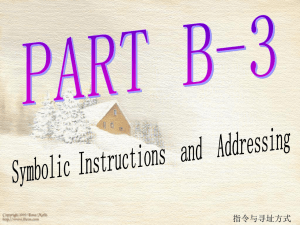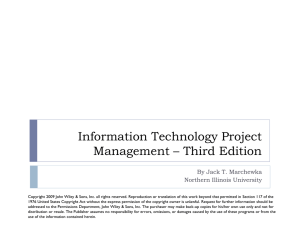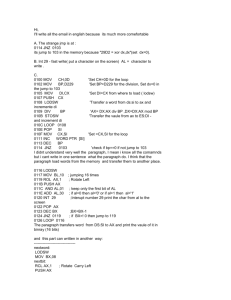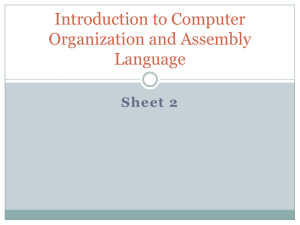File
advertisement
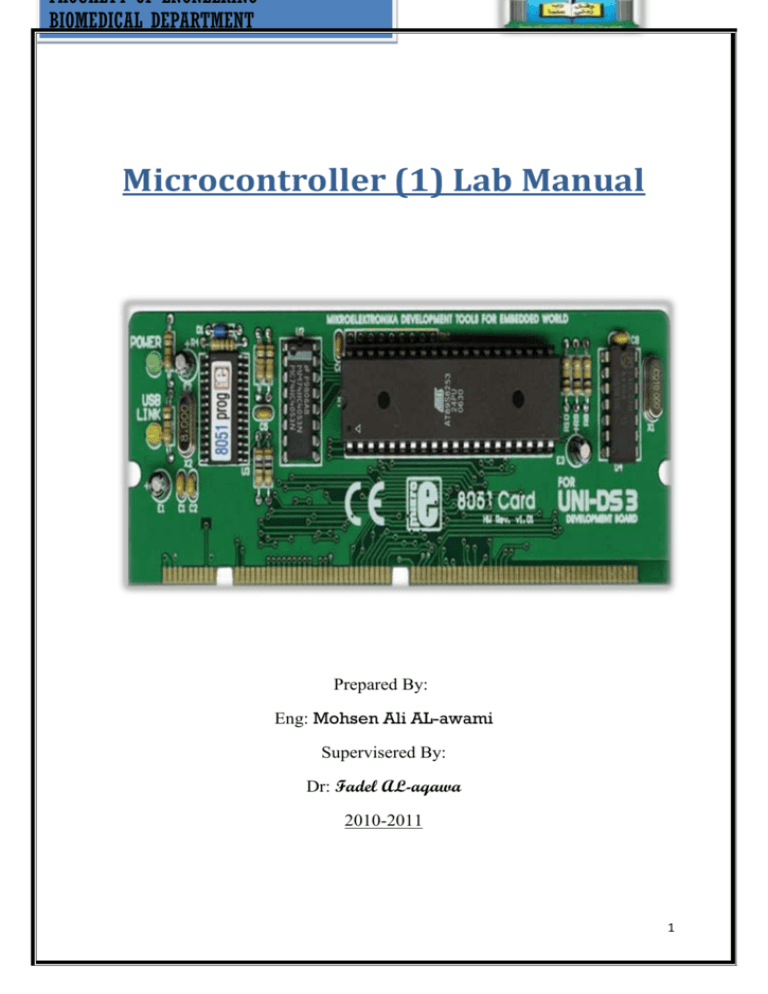
FACUALTY OF ENGNEERING BIOMEDICAL DEPARTMENT Microcontroller (1) Lab Manual Prepared By: Eng: Mohsen Ali AL-awami Supervisered By: Dr: Fadel AL-aqawa 2010-2011 1 LAB Expeirment (2) Main Topics: Jump ,Loop and Call instructions Assembely Arthimatics and Logic Operations Learning Objectives/Tasks: Upon Completion this experiment ,you will be able to : Code 8051 assembly language instruction using loops Code 8051 assembly language conditional jump instructions Explain condition that determine each conditional jump instruction Code 8051 subroutines Describe precautions in using the stack in subroutines Define the range of numbers possible in 8051 unsigned data Code addition and subtraction instructions for unsigned data Define the range of numbers possible in 8051 signed data Code addition and subtraction instructions for signed data Explain carry and overflow problems and their corrections Define the truth table for logic function AND,OR and XOR Code 8051 assembly language logic function instructions Section 1: Loop and jump instructions Repeating a sequence of instructions a certain number of times are called a LOOP, The loop is one of the most widely used actions is performed by the instraction [‘’ DJNZ reg, lable ‘’]. 2 In this instruction, the register is decremented, if not zero, it jump to target address referred to by the label. Example 1: Write a program to (a) Clear ACC (b) Add 3 to accumulator ten times Solution: AGAIN: Mov A,#0 ;a=0 clear ACC Mov R2,#10 ADD A,#03 ; load counter r2=10 ; add 03 to acc Djnz R2, AGAIN ;repeat untel r2=0 (10 times ) Mov R5,A ; save A in R5 Example 2: What is maximum number of times that the loop in last example can be repeated? Solution: Since the holds the count and R2 ia an 8-bites register, it can be hold maximum of FFH (256 in decimal times) Loop inside a loop: As shown in Example 2 the maximum number of count is 256 , what happens if we want to repeat an action more times than 256? To do that, we use loop in side loop which is called a nested loop 3 Example 3: Write a program to (a) load the accumulator with the value 55H (b) complement the ACC 700 times Solution: ; Since 700 is larger than 255 (the maximum capacity of any register), so we will use two registers to hold account. Mov A,#55h ; A=55 Mov R3,#10 ; r3=10 NEXT : Mov R2,#70 ; r2=70 AGAIN: CPL A ;compelement A DJNZ R2 , AGAIN ;repeat it 70 times (inner loop) DJNZ R3 , NEXT Other Conditional Jumps Conditional jumps for the 8051 are summerized in the next table: Such as JZ (jump if A =0) JC (jump if carry =1 ) instraction Action JZ Jump if a=0 JNZ Jump if a not= 0 DJNZ Decrement and Jump if a not=0 CJNE A,BYTE Jump if a not= byte CJNE REG,#DATA Jump if a not= #data 4 JC Jump if carry=1 JNC Jump if carry=0 JB Jump if bit=1 JNB Jump if bit=0 JBC Jump if bit=1 and clear bit All conditional jumps are short jumps: The address of the target must within -128 to +127 bytes of the contents of PC Example 4: Write a program to determine if R5 contains the value 0 .if so, put 55H in it. Solution: Mov A,R5 ;copy R5 to A JNZ NEXT ;jump if A is not zero Mov R5,#55H NEXT: ………………………… JNC(jump if no carry, jumps if cy=0): In executing ‘’JNC’’ ,the processor looks at the carry flag to see if it raised (cy=1).if it is not ,the CPU starts to fetch and execute instructions from the address of the label .if the carry =1 ,it will not it will execute the next instraction below JNC. It need to be noted that there is also ‘’JC lable ’’ instruction .in the jc instruction, if cy=1 it jumps to the target address. 5 Example 5: Find the sum of the values 79H,F5H and E2H.put the sum in the registers R0(low byte)and R5(high byte). Solution: N1: N2 : OVER: Mov A,#0 ; clear A (A=0) Mov R5,A ; clear R5 ADD A,#79H ; A=0+79H=79H JNC N1 ; if no carry ,add next number INC R5 ;if cy=1,increment R5 ADD A,#0F5H ; A=79+F5=6E JNC N2 ; jump if cy=0 INC R5 ; if cy=1 ,then incerement R5 ADD A,#0E2H ; A=6E+E2=50 and CY=1 JNC over ; jump if cy=0 INC R5 ; if cy=1 ,then incerement R5 mov R0,A ;Now R0=50h , and R5 =02 SS The unconditional jump is a jump in which control is transferred unconditionally to the target location LJMP (long jump) 3-byte instruction First byte is the opcode Second and third bytes represent the 16-bit target address – Any memory location from 0000 to FFFFH SJMP (short jump) 2-byte instruction First byte is the opcode Second byte is the relative target address – 00 to FFH (forward +127 and backward -128 bytes from the current PC). 6 Call instructions Call instruction is used to call subroutine Subroutines are often used to perform tasks that need to be performed frequently This makes a program more structured in addition to saving memory space LCALL (long call) o 3-byte instruction First byte is the opcode Second and third bytes are used for address of target subroutine – Subroutine is located anywhere within 64K byte address space ACALL (absolute call) o 2-byte instruction 11 bits are used for address within 2K-byte range When a subroutine is called, control is transferred to that subroutine, the processor Saves on the stack the the address of the instruction immediately below the LCALL Begins to fetch instructions form the new location After finishing execution of the subroutine The instruction RET transfers control back to the calle Every subroutine needs RET as the last instruction 7 Example 6: ORG 0 BACK: MOV A,#55H MOV P1,A LCALL DELAY MOV A,#0AAH MOV P1,A LCALL DELAY SJMP BACK ;---------- this is ORG 300H DELAY:MOV R5,#0FFH AGAIN:DJNZ R5,AGAIN RET END 001 002 003 004 005 006 007 008 009 010 011 012 013 014 015 016 0000 0000 0002 0004 0007 0009 000B 000E 0010 0010 0300 0300 0300 0302 0304 0305 ;load ;send ;time ;load ;send A with 55H to delay A with AAH to 55H port 1 AA (in hex) port 1 ;keep doing this indefinitely delay subroutine -----------;put DELAY at address 300H ;R5=255 (FF in hex), counter ;stay here until R5 become 0 ORG 0 7455 BACK: MOV A,#55H F590 MOV P1,A 120300 LCALL DELAY 74AA MOV A,#0AAH F590 MOV P1,A 120300 LCALL DELAY 80F0 SJMP BACK ;load ;send ;time ;load ;send A with 55H to delay A with AAH to 55H p1 AAH p1 ;keep doing this ;-------this is the delay subroutine-----ORG 300H DELAY: 7DFF MOV R5,#0FFH ;R5=255 DDFE AGAIN: DJNZ R5,AGAIN ;stay here 8 22 RET ;return to caller END ;end of asm file Stack fram after the first LCALL 08 0A 09 08 00 07 Low byte goes first then high byte SP (stack pointer) = 09 The use of ACALL instead of LCALL can save a number of bytes of program ROM space . 9 ARITHMETIC & LOGIC INSTRUCTIONS AND PROGRAMS Assembely Arthimatics Operations: Addition of unsigned numbers ADD A,source ;A = A + source The instruction ADD is used to add two operands Destination operand is always in register A Source operand can be a register, immediate data, or in memory Memory-to-memory arithmetic operations are never . Example 1: Show how the flag register is affected by the following instruction. MOV A,#0F5H ;A=F5 hex ADD A,#0BH ;A=F5+0B=00 Solution: F5H 1111 0101 + 0BH + 0000 1011 -------- ----------100H 0000 0000 When adding two 16-bit data operands,the propagation of a carry from lower byte to higher byte is concerned. Example 2: 1 3C E7 + 3B 8D --------78 74 10 Write a program to add two 16-bit numbers. Place the sum in R7 and R6; R6 should have the lower byte. Solution: CLR C MOV A, #0E7H ADD A, #8DH MOV R6, A MOV A, #3CH ADDC A, #3BH MOV R7, A ;make CY=0 ;load the low byte now A=E7H ;add the low byte ;save the low byte sum in R6 ;load the high byte ;add with the carry ;save the high byte sum o The binary representation of the digits 0 to 9 is called BCD (Binary Coded Decimal) Unpacked BCD In unpacked BCD, the lower 4 bits of the number represent the BCD number, and the rest of the bits are 0 . Ex. 00001001 and 00000101 are unpacked BCD for 9 and 5. Packed BCD In packed BCD, a single byte has two BCD number in it, one in the lower 4 bits, and one in the upper 4 bits . Ex. 0101 1001 is packed BCD for 59H. o Adding two BCD numbers must give a BCD result. Example 2: MOV A, #17H ADD A, #28H The result above should have been 17 + 28 = 45 (0100 0101). To correct this problem, the programmer must add 6 (0110) to the low digit: 3F + 06 = 45H. DA A ;decimal adjust for addition The DA instruction is provided to correct the aforementioned problem associated with BCD addition 11 The DA instruction will add 6 to the lowe nibble or higher nibble if need . Example 3 : MOV A,#47H MOV B,#25H ADD A,B DA A ;A=47H first BCD operand ;B=25H second BCD operand ;hex(binary) addition(A=6CH) ;adjust for BCD addition (A=72H) The “DA” instruction works only on A. In other word, while the source can be an operand of any addressing mode, the destination must be in register A in order for DA to work. Subtraction of unsigned numbers : In many microprocessor there are two different instructions for subtraction: SUB and SUBB (subtract with borrow) In the 8051 we have only SUBB The 8051 uses adder circuitry to perform the subtraction SUBB A,source ;A = A – source – CY To make SUB out of SUBB, we have to make CY=0 prior to the execution of the instruction Notice that we use the CY flag for the borrow SUBB when CY = 0 1. Take the 2’s complement of the subtrahend (source operand) 2. Add it to the minuend (A) 3. Invert the carry 12 Example 4: CLR C MOV A,#4C SUBB A,#6EH JNC NEXT CPL A INC A NEXT: MOV R1,A Solution: 4C 0100 1100 6E 0110 1110 ----22 ;load A with value 4CH ;subtract 6E from A ;if CY=0 jump to NEXT ;if CY=1, take 1’s complement ;and increment to get 2’s comp ;save A in R1 0100 1001 ----01101 1100 0010 ----1110 SUBB when CY = 1 This instruction is used for multi-byte numbers and will take care of the borrow of the lower operand . Example 5: CLR C MOV A,#62H ;A=62H SUBB A,#96H ;62H-96H=CCH with CY=1 MOV R7,A ;save the result MOV A,#27H ;A=27H SUBB A,#12H ;27H-12H-1=14H MOV R6,A ;save the result Solution: We have 2762H - 1296H = 14CCH. 13 SIGNED ARITHMETIC INSTRUCTIONS (Signed 8-bit Operands ) D7 (MSB) is the sign and D0 to D6 are the magnitude of the number If D7=0, the operand is positive, and if D7=1, it is negative Positive numbers are 0 to +127 Negative number representation (2’s complement) 1. Write the magnitude of the number in 8-bit binary (no sign) 2. Invert each bit 3. Add 1 to it. -- D7 D6 Sign D5 D4 D3 D2 D1 D0 -- Magnitude Show how the 8051 would represent -34H Solution: 1. 0011 0100 34H given in binary 2. 1100 1011 invert each bit 3. 1100 1100 add 1 (which is CC in hex) Signed number representation of -34 in 2’s complement is CCH SIGNED ARITHMETIC INSTRUCTIONS (Overflow Problem) If the result of an operation on signed numbers is too large for the register. An overflow has occurred and the programmer must be noticed. 14 Examine the following code and analyze the result. MOV A,#+96 ;A=0110 0000 (A=60H) MOV R1,#+70 ;R1=0100 0110(R1=46H) ADD A,R1 ;A=1010 0110 ;A=A6H=-90,INVALID Solution: +96 0110 0000 + +70 0100 0110 ----------------+ 166 1010 0110 and OV =1 According to the CPU, the result is -90, which is wrong. The CPU sets OV=1 to indicate the overflow SIGNED ARITHMETIC INSTRUCTIONS (2's Complement) To make the 2’s complement of a number CPL A ADD A,#1 ;1’s complement (invert) ;add 1 to make 2’s comp. LOGIC AND COMPARE INSTRUCTIONS (1- AND LOGIC) ANL destination,source ;dest = dest AND source This instruction will perform a logic AND on the two operands and place the result in the destination The destination is normally the accumulator The source operand can be a register, in memory, or immediate 15 Example 1: Show the results of the following. MOV A,#35H ;A = 35H ANL A,#0FH ;A = A AND 0FH 35H 0 0 1 1 0FH 0 0 0 0 = ------- -------05H 0 0 0 0 0 1 0 1 1 1 1 1 ----------0 1 0 1 (2- OR LOGIC) ORL destination,source ;dest = dest OR source The destination and source operands are ORed and the result is placed in the destination . The destination is normally the accumulator The source operand can be a register, in memory, or immediate . Example 2: Show the results of the following. MOV A,#04H ;A = 04 ORL A,#68H ;A = 6C 04H 68H =----6CH 0 0 0 0 0 1 1 0 --------0 1 1 0 0 1 0 0 1 0 0 0 --------1 1 0 0 16 (3- XOR) XRL destination, source ;dest = dest XOR source This instruction will perform XOR operation on the two operands and place the result in the destination The destination is normally the accumulator The source operand can be a register, in memory, or immediate . Example 3: Show the results of the following. MOV A,#54H XRL A,#78H 54H 78H = -----2CH 0 1 0 1 0 1 0 0 0 1 1 1 1 0 0 0 -------- ---------0 0 1 0 1 1 0 0 4- Compare Instruction CJNE destination,source,rel. addr. The actions of comparing and jumping are combined into a single instruction called CJNE (compare and jump if not equal) The CJNE instruction compares two operands, and jumps if they are not equal. The destination operand can be in the accumulator or in one of the Rn registers The source operand can be in a register, in memory, or immediate The operands themselves remain unchanged. It changes the CY flag to indicate if the destination operand is larger or smaller. Example 4: CJNE R5,#80,NOT_EQUAL ... ;check R5 for 80 ;R5 = 80 JNC NEXT ... ... ;jump if R5 > 80 ;R5 < 80 NOT_EQUAL: NEXT: 17 Compare Carry Flag destination ≥ source CY = 0 destination < source CY = 1 The compare instruction is really a Subtraction. Rotating Right and Left RR A ;rotate right A In rotate right The 8 bits of the accumulator are rotated right one bit, and Bit D0 exits from the LSB and enters into MSB, D7 MSB MOV A,#36H RR A RR A RR A RR A t’) LSB ;A ;A ;A ;A ;A = = = = = 0011 0001 1000 1100 0110 0110 1011 1101 0110 0011 RL A ;rotate left A In rotate left The 8 bits of the accumulator are rotate left one bit, and Bit D7 exits from the MSB and enters into LSB, D0 MSB LSB 18 MOV A,#72H RL A RL A ;A = 0111 0010 ;A = 1110 0100 ;A = 1100 1001 Rotating through Carry RRC A ;rotate right through carry In RRC A Bits are rotated from left to right They exit the LSB to the carry flag, and the carry flag enters the MSB. CY MSB CLR MOV RRC RRC RRC C A,#26H A A A LSB ;make CY = 0 ;A = 0010 0110 ;A = 0001 0011 CY = 0 ;A = 0000 1001 CY = 1 ;A = 1000 0100 CY = 1 RLC A ;rotate left through carry In RLC A Bits are shifted from right to left. They exit the MSB and enter the carry flag, and the carry flag enters the LSB. CY MSB LSB 19 Write a program that finds the number of 1s in a given byte. MOV R1,#0 MOV R7,#8 ;count=08 MOV A,#97H AGAIN: RLC A JNC NEXT ;check for CY INC R1 ;if CY=1 add to count NEXT: DJNZ R7,AGAIN 20



